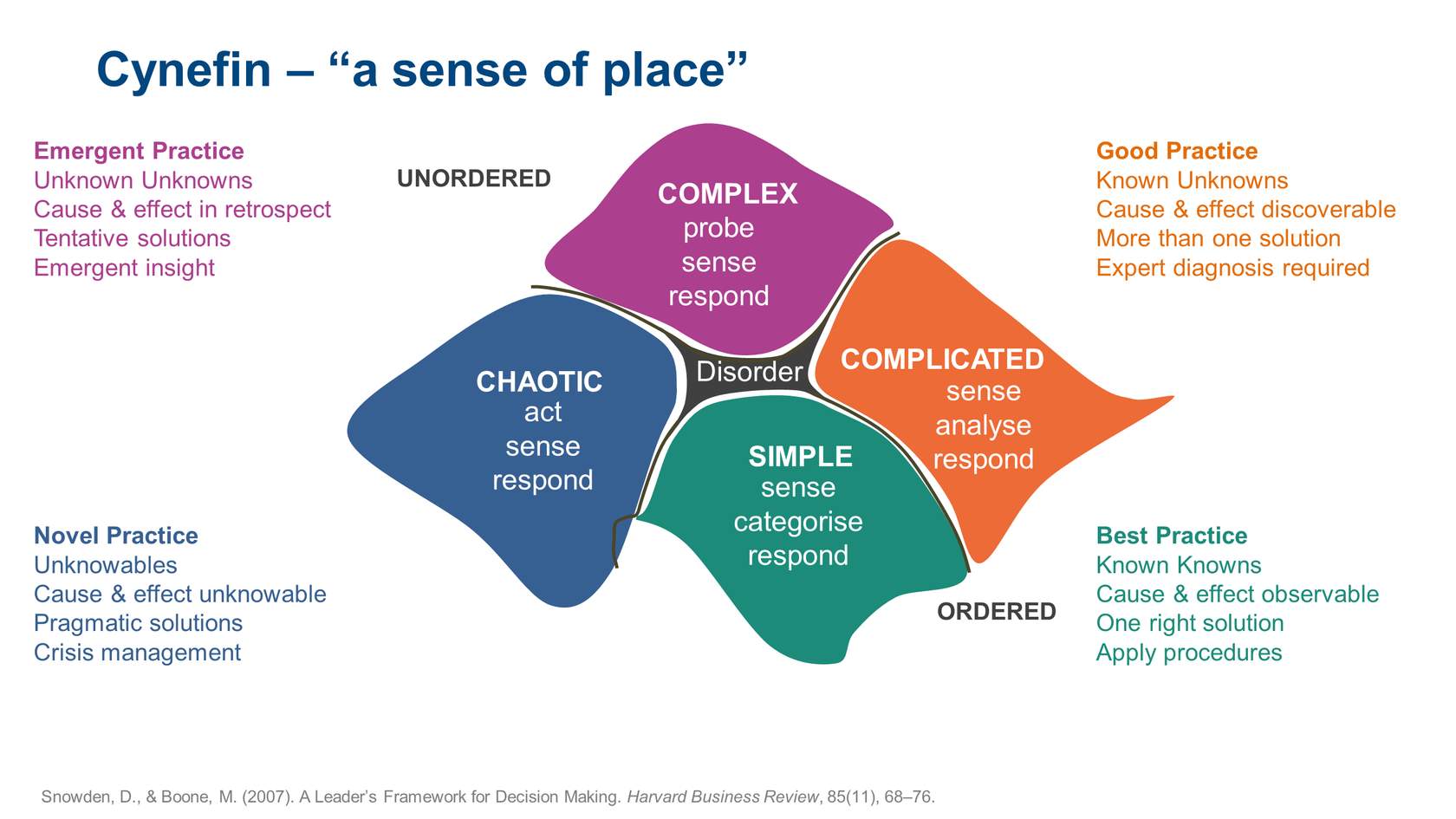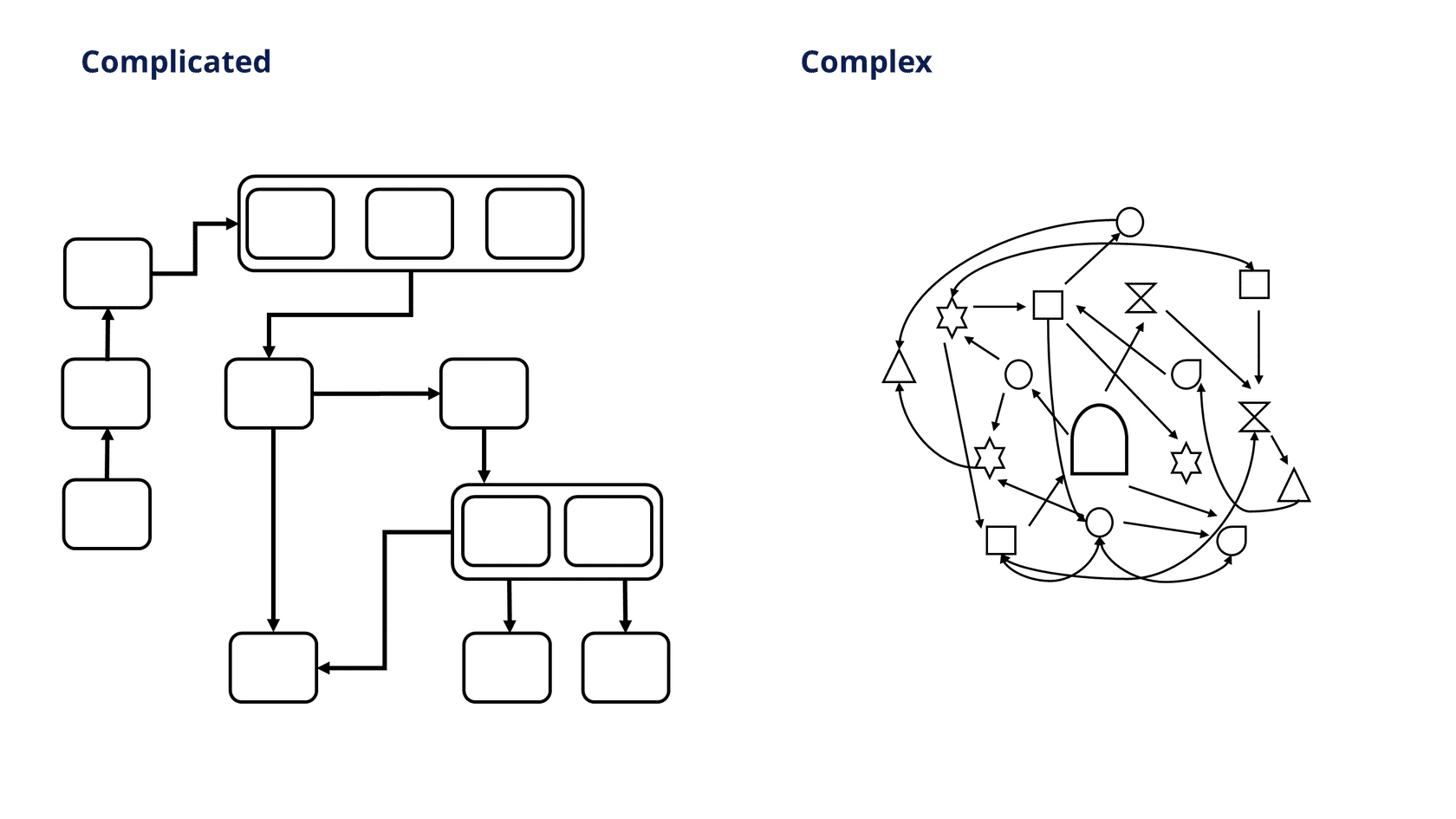2 The Cynefin Framework, Ambidexterity: Decision Framing
The Cynefin Framework, Ambidexterity: Decision Framing
The Cynefin Framework by David Snowden suggests that by addressing issues from the place of complexity thinking, we not only have a way to work but it also gives us a divergent way of thinking. This is based on that idea that the more input into our thinking and decisions models, the more possibilities and opportunities we can explore.
This leads to the concept of requisite variety. Recent work at QUT suggests that government policy makers and strategists must look more broadly and widely as they explore external trends. The idea that external factors need to be context specific is a dangerous and outdated idea. Rather than scenario planning that leads to plausibility and highly likely outcomes and certainly, agencies that are truly looking for transformative future models, must be focused on scenario thinking and implausibility!
This ambidexterity and bimodality is essential in the rapidly evolving space of digital transformation in state and national agencies and departments. The more powerful and varied the inputs, the greater the likelihood of true transformation in the public sector and beyond.
The fashion in the public sector is for claiming ‘It is OK to fail, just fail fast’. (a better sentence required here). Culture and circumstances rarely allow for such experimentation. One tool often used is the scenario planning model.
However, many who use scenario planning models carefully focus on the element of ‘planning’ when conducting their analysis, and use the process and like-minded people to create ‘plausible’ outcomes and possibilities.
In our view, that leads to ‘same’, and at times either less than optimal possible solutions, or even worse, catastrophe.
We are proponents of scenario thinking, and the idea of implausibility! Because indeed the implausible can powerfully suggest new models and ways of thinking, and it will also allow for contemplation of those potentially unwelcome events and outcomes that may create disaster. Traditional scenario planned has a bias towards the known and safe, simply because the process ultimately creates a false sense to security and a ‘green lighting’ effect.
Scenario thinking allows for strategy teams to experiment with the complex, chaos and disorder elements of the Cynefin decision framework.
In short, use the Strategy Mapping tool to create and enact better and more successful strategies, and use expansive models and techniques to leverage current capabilities, and design the future!
Ambidexterity is essential as a strategy mindset!
Framing problems and decisions
You have just spent some time engaging in a serious play activity. You worked to solve a problem that you wanted to overcome in your workplace.
Let’s hope it was successful. At the least you now have a new technique to use when you need to focus on a specific issue.
We want you to investigate more thoroughly the nature of a problem. You as much as anyone know that problems are not created equal. David Snowden of The Cognitive Edge has spent many years developing the concept of The Cynefin Framework1 which is a problem and decision-framing approach. You may have seen this concept in some of your other units. This complexity-framing model is one of the key thinking models that we use at QUT. If you have used it already keep going as each time you approach a new issue or problem with The Cynefin Framework, it is likely that you will learn something new.
Understanding yourself and the Army’s context, and its operating environment is a highly complex task. Decisions must be made with less than perfect knowledge, especially with technical and battlefield dynamics disrupting long held assumptions. David Snowden proposes a decision framework for decision makers and those in the field.
To set started, watch the YouTube video (below). As you watch, here are some things to keep in mind and things to look out for:
Snowden reminds us that when we are confronted with situations when we need to decide and act, we will interpret the situation and act according to our personal preferences for action.
- Consider where in the decision framework you tend to operate. What kinds of problems are you usually faced with?
- Note how you respond to each of the quadrants and think about how you see problems and potential solutions.
- Listen carefully for the nuances about each space and be careful about the ‘cliff space’ between Simple and Chaotic. The template below will help you with this.

Reflection activity
Consider your observations and reactions in the context of your current, and perhaps, past situations of decisions making, actions and outcomes.
How does the framework add to your understanding of how you, your teams and the Army overall see and make decisions?
How might you use this complexity decision framework in your own work?
Think about your own view of the world. What is your default approach to issues and decision situations?
Think about how you might share with your immediate team your insights and preferences.
How might you deal with these in your work context? What impact will your preferences
and those of others, have on the outcomes?
To sum up, Snowden says The Cynefin Framework “gives us a very easy way of deciding how to work but it (also) gives us a divergent (way of thinking) – we sometimes call this requisite applicability. It basically says dependent on which space you’re in, you should think differently, should analyze differently, rather than one-size-fits-all which has been a tradition of management theory”.2
Here is a final word that might help you put this lesson in context and get us ready for the next lesson. The famous American General Stanley McChrystal3 discusses complicated and complex in detail. He represents the differences in this way:

Adapted from: McChrystal, S. C., Tantum; Silverman, David; Fussel, Chris. (2015). Team of Teams: New Rules of Engagement for a Complex World. Portfolio Penguin.
He says that complexity occurs when the number of interactions between components increases dramatically. His wrap-up statement is that the world has become in many ways less predictable despite technology and data-gathering and mining advances.
References
- Snowden, D. J., & Boone, M. E. (2007). A leader’s framework for decision making. Harvard business review, 85(11), 68.
- Ibid.
- McChrystal, S. C., Tantum; Silverman, David; Fussel, Chris. (2015). Team of Teams: New Rules of Engagement for a Complex World. Portfolio Penguin.
The concept of more inputs than necessarily to generate optimal opportunities and outputs

